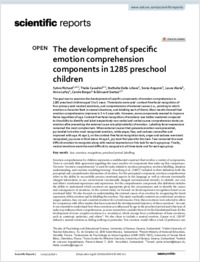The development of specific emotion comprehension components in 1285 preschool children
Apprentissages fondamentaux
- Richard, Sylvie HEP-VS
- Cavadini, Thalia Faculty of Psychology and Educational Science, University of Geneva
- Dalla-Libera, Nathalie French Ministry of National Education, Grenelle, France
- Angonin, Sonia French Ministry of National Education, Grenelle, France
- Alaria, Laura Institut de sciences logopédiques, Neuchâtel
- Lafay, Anne Laboratoire de Psychologie et NeuroCognition, University of Savoie Mont Blanc, Chambéry, France
- Berger, Carole Laboratoire de Psychologie et NeuroCognition, University of Savoie Mont Blanc, Chambéry, France
- Gentaz, Edouard Faculty of Psychology and Educational Science, University of Geneva
- 2025
Published in:
- Scientific Reports. - 2025, no. 15
English
The goal was to examine the development of specific components of emotion comprehension in 1285 preschool children aged 3 to 5 years. Three tasks were used: context-free facial recognition of four primary (and neutral) emotions, and comprehension of external causes (i.e., pointing to which emotion a character feels in several situations, and labelling each of them). Main results showed that emotion comprehension improves in 3-4-5-year-olds. However, some components seemed to improve faster regardless of age. Context-free facial recognition of emotions was better mastered compared to the ability to identify and label (respectively non-verbal and verbal causes comprehension tasks) an emotion after presenting the external cause (visually/verbally) of emotion. Labelling facial expressions remained the most complex task. When external causes that generate emotion were presented, joy tended to be the most recognized emotion, while anger, fear, and sadness came after and improved with age. At age 3, on the context-free facial recognition task, anger and sadness were best recognized, joy came in third place. At age 5, joy took first place for this task. Fear remained the most difficult emotion to recognize along with neutral expression on this task for each age group. Finally, neutral emotions were the most difficult to recognize in all three tasks and for each age group.
- Language
-
- English
- Related to
- License
- Open access status
- gold
- Identifiers
- Persistent URL
- https://fredi.hepvs.ch/hepvs/documents/331236
Statistics
Document views: 170
File downloads:
- Richard_Sylvie_et_al_Development of_specific_emotion_comprehension_components: 62
